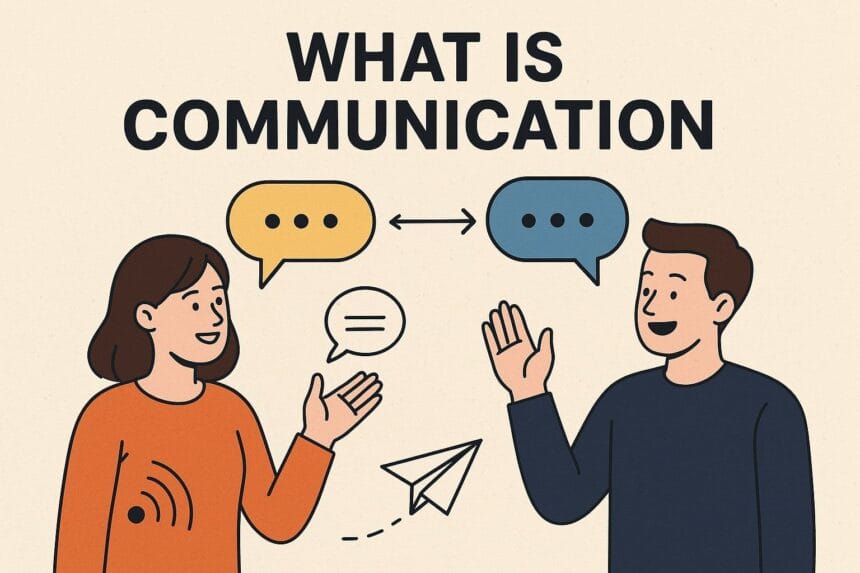Understanding Communication: Definition and Core Concepts
Communication is more than just talking; it’s the art of conveying information effectively so others understand your message. This involves not only the words you choose but also your tone, body language, and even the silences you use.
Effective communication is crucial in both personal and professional settings. Studies show that strong communication skills can boost team productivity significantly. Let’s explore what communication truly entails, its mechanics, various forms, importance, potential roadblocks, and strategies for improvement.
Defining Communication
Communication is the process of conveying information in a way that ensures mutual understanding. It encompasses verbal and non-verbal cues, ensuring the recipient interprets the message as intended. This involves active listening, empathy, and clarity in expression.
Basic Details of Communication
| Aspect | Description |
|---|---|
| Definition | Sharing information in a way others can understand. |
| Origin | From the Latin word “communicare,” meaning “to share.” |
| Historical Context | Formal use began in the 14th century. |
| Father of Communication | Aristotle, who first studied communication as a structured process. |
| Main Purpose | To connect, inform, express, and foster understanding among individuals. |
| Types | Verbal, non-verbal, written, and visual. |
| Applications | Personal life, workplace, education, and broader society. |
| Significance | Builds trust, prevents misunderstandings, and enhances relationships and productivity. |
| Essential Skills | Active listening, clarity, empathy, confidence, and effective use of body language. |
Effective Communication: Examples and Key Elements
Effective communication guarantees that your message is received and understood exactly as you meant it. Clarity is paramount, leaving no room for ambiguity.
Examples of Effective Communication
- Clear Instructions: A manager provides concise and unambiguous instructions to their team, ensuring everyone knows their responsibilities.
- Constructive Feedback: Offering feedback that is specific, actionable, and delivered with empathy to help someone improve.
- Active Listening: Fully concentrating on what someone is saying, asking clarifying questions, and responding thoughtfully.
- Respectful Dialogue: Engaging in conversations where all parties feel heard and valued, even when differing opinions exist.
The Communication Process Explained
Communication isn’t merely talking; it’s a multi-stage process. A breakdown at any stage can lead to misunderstanding or complete message failure.
- Idea Formulation: Everything starts with an idea or thought you want to convey.
- Encoding: Transforming your thought into a message format suitable for transmission (words, gestures, etc.).
- Transmission: Selecting and using a medium to send your message (face-to-face, email, phone call, etc.).
- Reception: The recipient receives the message through their senses.
- Decoding: The recipient interprets the message to understand its meaning.
- Feedback: The recipient provides a response, indicating their understanding (or lack thereof).
- Noise: Any interference that disrupts the message flow (distractions, language barriers, etc.).
Types of Communication
We use various communication methods depending on the context. Here’s a breakdown of common types:
- Verbal Communication: Spoken words used to share information. Examples include conversations, presentations, and phone calls. Example: A doctor explains a diagnosis to a patient using clear and simple language.
- Written Communication: Messages conveyed through written text, such as emails, reports, and letters. Example: A company sends out a memo detailing new policies.
- Non-Verbal Communication: Body language, facial expressions, and gestures used to convey meaning. Example: Nodding to show agreement during a conversation.
- Visual Communication: Using images, charts, and other visual aids to communicate information. Useful for complex data or concepts. Example: A presentation uses graphs to illustrate market trends.
- Intrapersonal Communication: Internal dialogue and self-reflection. Influences our self-perception and decision-making. Example: Pep talk before a big presentation.
- Interpersonal Communication: Communication between two or more people. Essential for building relationships and teamwork. Example: Two colleagues brainstorming ideas for a project.
Why Communication Matters
Effective communication forms the bedrock of strong relationships and professional success:
- Clarity: Enables clear expression of thoughts and emotions.
- Trust: Fosters trust in both personal and professional relationships.
- Teamwork: Enhances teamwork and coordination within groups.
- Accuracy: Reduces misunderstandings and errors.
- Efficiency: Streamlines decision-making processes.
- Leadership: Strengthens leadership capabilities and influence.
- Relationships: Supports healthy relationships at home and work.
- Problem-Solving: Facilitates calm and effective conflict resolution.
Overcoming Communication Barriers
Several factors can impede effective communication:
- Language Barriers: Use of jargon, complex terms, or unfamiliar language.
- Physical Barriers: Noise, distance, or poor connectivity.
- Emotional Barriers: Stress, anger, or lack of confidence.
- Cultural Differences: Misinterpretations due to varying cultural norms.
- Inattention: Lack of focus or active listening.
- Timing Issues: Inappropriate timing for delivering a message.
- Assumptions: Making premature judgments without complete information.
- Technological Issues: Glitches or delays in digital communication.
Honing Your Communication Skills
Communication is a skill that can be developed and improved over time. Here are some practical tips:
- Practice Active Listening: Pay close attention to what others are saying.
- Keep it Simple: Use clear and concise language.
- Think Before Speaking: Consider your words carefully.
- Be Mindful of Body Language: Use non-verbal cues effectively.
- Ask Clarifying Questions: Ensure you understand the message.
- Provide Constructive Feedback: Offer helpful and respectful feedback.
- Stay Calm: Maintain composure during difficult conversations.
- Avoid Interrupting: Allow others to finish their thoughts.
- Maintain Eye Contact: Show engagement and sincerity.
- Practice Regularly: Rehearse speaking in front of a mirror or with a friend.






